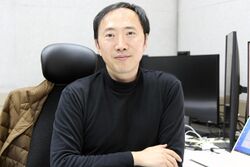Biography:Young-Tae Chang
Young-Tae Chang | |
|---|---|
장영태 | |
 | |
| Born | 1968 Pusan, South Korea |
| Scientific career | |
| Doctoral advisor | Sung-Kee Chung |
| Other academic advisors | Peter G. Schultz |
| Korean name | |
| Revised Romanization | Jang Yeongtae |
| McCune–Reischauer | Chang Yŏngt'ae |
| Website | http://ytchang.postech.ac.kr |
Young-Tae Chang is a South Korean chemist. He is a professor of chemistry at Pohang University of Science and Technology (POSTECH) and Associate Director under Kim Kimoon at the Center for Self-assembly and Complexity at the Institute for Basic Science located on the POSTECH campus.
Young-Tae Chang was born in Pusan, South Korea in 1968. He obtained a Bachelor of Science degree in chemistry from POSTECH, working on the divergent synthesis of all regioisomers of myo-inositol phosphates, under guide of Prof. Sung-Kee Chung. Doctoral requirements at POSTECH require a student study at least three years, but Young-Tae finished in two, requiring his advisor to appeal for a revision of the rules which allowed him to receive his doctorate in February 1997.[1] He then engaged in postdoctoral research in the laboratory of Prof. Peter G. Schultz at University of California, Berkeley and Scripps Research in 2000.
He was appointed assistant professor at New York University (NYU) and promoted to associated professor in 2005. In September 2007, he moved to the National University of Singapore and the Singapore Bioimaging Consortium at Biopolis. From 2017, he is a Full Professor in the Department of Chemistry, POSTECH and head of the Laboratory of Bioimaging Probe Development at SBIC. He pioneered diversity-oriented fluorescence library approach (DOFLA),[2][3] and developed embryonic stem cell probe CDy1,[4] neuronal stem cell probe CDr3,[5] and neron specific probe, NeuO.[6] He also developed a method for background-free live cell imaging with tamed fluorescent probe.[7]
He is an editorial board member of MedChemComm and RSC Advances, Royal Society of Chemistry, and American Journal of Nuclear Medicine and Molecular Imaging. He has published more than 300 scientific papers and 3 books resulting in more than 22,000 citations.[8] Additionally, he has filed more than 50 patents.
Honors and awards
- 2023: Yoshida Prize, International Organic Chemistry Foundation[9][10]
- 2022: Sang-Chul Shim Academic Award, Korean Chemical Society[11][12]
- 2007: NUS Young Investigator Award
- 2005: Career Award, National Science Foundation
References
- ↑ 최준석 (20 July 2020). "암세포에 색깔 입히는 형광물질 연구자 장영태 포항공대 교수" (in Korean). http://weekly.chosun.com/client/news/viw.asp?ctcd=C08&nNewsNumb=002617100021.
- ↑ VENDREL, MARC; Duanting Zhai; Jun Cheng Er; Young-Tae Chang (2012). "Combinatorial strategies in fluorescent probe development". Chem. Rev. 112 (8): 4391–4420. doi:10.1021/cr200355j. PMID 22616565.
- ↑ Nam-Young Kang; Hyung-Ho Ha; Seong-Wook Yun; Young Hyun Yu; Young-Tae Chang (2011). "Diversity-driven chemical probe development for biomolecules: beyond hypothesis-driven approach". Chem. Soc. Rev. 40 (7): 3613–3626. doi:10.1039/C0CS00172D. PMID 21526237.
- ↑ Chang-Nim Im; Nam-Young Kang; Hyung-Ho Ha; Xuezhi Bi; Jae Jung Lee; Sung-Jin Park; Sang Yeon Lee; Marc Vendrell et al. (2010). "A Fluorescent Rosamine Compound Selectively Stains Pluripotent Stem Cells". Angew. Chem. Int. Ed. 49 (41): 7497–7500. doi:10.1002/anie.201002463. PMID 20814992.
- ↑ Seong-Wook Yun; Cheryl Leong; Duanting Zhai; Yee Ling Tan; Linda Limd; Xuezhi Bi; Jae-Jung Lee; Han Jo Kim et al. (2012). "Neural stem cell specific fluorescent chemical probe binding to FABP7". PNAS 109 (26): 10214–10217. doi:10.1073/pnas.1200817109. PMID 22689954. Bibcode: 2012PNAS..10910214Y.
- ↑ Er, Jun Cheng; Leong, Cheryl; Teoh, Chai Lean; Yuan, Qiang; Merchant, Paolomi; Dunn, Matthew; Sulzer, David; Sames, Dalibor et al. (2015-02-16). "NeuO: a fluorescent chemical probe for live neuron labeling". Angewandte Chemie International Edition in English 54 (8): 2442–2446. doi:10.1002/anie.201408614. ISSN 1521-3773. PMID 25565332.
- ↑ Alamudi, Samira Husen; Satapathy, Rudrakanta; Kim, Jihyo; Su, Dongdong; Ren, Haiyan; Das, Rajkumar; Hu, Lingna; Alvarado-Martínez, Enrique et al. (2016-01-01). "Development of background-free tame fluorescent probes for intracellular live cell imaging". Nature Communications 7: 11964. doi:10.1038/ncomms11964. ISSN 2041-1723. PMID 27321135. Bibcode: 2016NatCo...711964A.
- ↑ "Young-Tae Chang - Google Scholar Citations". 22 January 2019. https://scholar.google.com/citations?user=q6s4ZzAAAAAJ.
- ↑ "6th Yoshida Prize Symposium". https://iocf.sbchem.kyoto-u.ac.jp/en/report-yoshida-prize/6th-yoshida-prize-symposium/.
- ↑ "Yoshida Prize". https://iocf.sbchem.kyoto-u.ac.jp/en/yoshida-prize/.
- ↑ 김만기 (21 April 2022). "POSTECH 장영태 교수, 대한화학회 학술상 수상" (in Korean). https://www.fnnews.com/news/202204211322016944.
- ↑ 이시라 (21 April 2022). "포스텍 장영태 교수, '심상철 학술상' 수상" (in Korean). http://www.kbmaeil.com/news/articleView.html?idxno=927330.
External links
- Professor CHANG Young-Tae, POSTECH
- Associate Director - Center for Self-assembly and Complexity
- Young-Tae Chang - Google Scholar
 |

